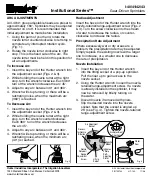
Innova Srl
Page 36
N420741A_manuale-HRC+2022 - rev.01 _EN
.docx
8
ALARMS
8.1.1
GENERALITY
In case of problems or breakdowns, take note of any error code appearing on the display of the electronic control unit or of the
remote control, take note of the model and serial number of the unit you own (present on the identification plate attached to the
side of the unit) and contact the installer.
8.1.2
PROBLEMS WITHOUT ERROR INDICATION ON THE DISPLAY
PROBLEM
CAUSE
REMEDIES
The fans are not active
-The power supply is not switched on
- The fan speed regulation device does not
work
- Wrong electrical connections
- Fans in thermal protection
-Check the power supply on the fan
- Check the fan speed adjustment device
-Check that the fan is not overheated and in thermal
protection
Insufficient air flow or
useful pressure
-Clogged filters
- Insufficient rotation speed
- Clogged pipes or exchanger
-Clean the filters
-Increase the rotation speed
-Clean pipes or exchanger
Insufficient efficiency of
the exchanger
- Exchanger fins clogged
-Clean the surfaces of the exchanger
Excessive vibration and
noise
-Incorrect installation of the drive
- Incorrect installation of the pipes
- Imbalance of the impeller of the fans
-Check the unit's brackets and fixings
-Check brackets and pipe fastenings
- Check the fan impellers status
Water leaks from the
unit
- Condensate drain blocked
-Siphon not installed correctly
-Clean the condensate drain
-Check the correct installation of the siphon
Difficult starting
- Supply voltage too low
Insufficient engine torque
-Check that the power supply voltage is not below 10% of the
rated voltage on the plate
-Power the unit with partially closed dampers in order to
reduce the motor starting torque. If starting correctly, replace
the motor with a larger one.
8.1.3
ALARM SIGNAL
Below is a list of all the alarms managed by the application.
The presence of an alarm has two display modes:
•
an error code present on the EQA649 / EQB649 or ERA649 / ERB649 command;
•
a led on the electronic board that shows a flashing sequence with the type of alarm present.






































